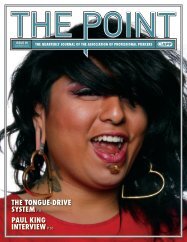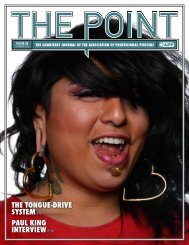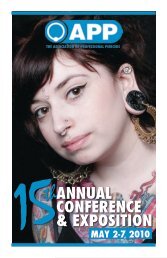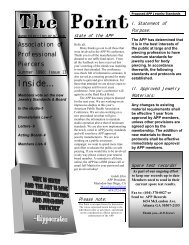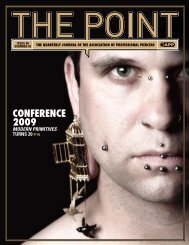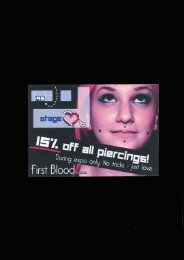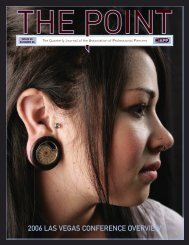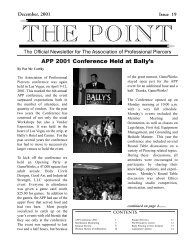Point Journal issue #56 - Association of Professional Piercers
Point Journal issue #56 - Association of Professional Piercers
Point Journal issue #56 - Association of Professional Piercers
You also want an ePaper? Increase the reach of your titles
YUMPU automatically turns print PDFs into web optimized ePapers that Google loves.
their own specific modifications, apparel, and<br />
jewelry, but it seems to be a more integral part<br />
<strong>of</strong> the lives and milestones <strong>of</strong> females: from<br />
henna to bangles and bracelets to tattooing. As<br />
you can see from the accompanying pictures on<br />
the preceding pages, traditional Indian tattoo<br />
designs are relatively sparse to Western eyes.<br />
They are far less intricate than, say, Japanesestyle<br />
tattoos—and are devoid <strong>of</strong> color. As<br />
Allison went from village to village, she saw<br />
all sorts <strong>of</strong> tattoos—mostly on women—and<br />
while the designs varied, there were repeated<br />
motifs from one community to another. (For<br />
example, tattoos on women, much like the one<br />
on the previous page, represent everything from<br />
a woman’s caste to marital status, while many<br />
other markings represent luck or, in the case<br />
<strong>of</strong> a black dot on a woman’s forehead or chin,<br />
protection, specifically from the “evil eye.”<br />
The same symbols appeared over and over, on<br />
women young to old.<br />
Certain piercings hold particular meanings,<br />
<strong>of</strong>ten representing the various stages <strong>of</strong> one’s<br />
life. And, as you can imagine, the jewelry<br />
chosen was just as deliberate. (The woman––<br />
above––wears gold rings through her nostrils,<br />
symbolic <strong>of</strong> an amorous ornamentation <strong>of</strong>ten<br />
connected with female sexuality, while her ears<br />
are adorned by several silver hoops.) Whether<br />
it be the numbers, colors, and materials <strong>of</strong><br />
bangles and bracelets, or the jewelry one wears<br />
through a nostril, in rural India everything<br />
is done deliberately and traditionally—<br />
though, predictably, many Indian cities have<br />
abandoned the old adornments in their shift<br />
toward modernity.<br />
While my only true taste <strong>of</strong> India was a<br />
single cup <strong>of</strong> c<strong>of</strong>fee, and the only tangible<br />
items I experienced were a few brass hair<br />
pins and assorted jewelry, I felt transported.<br />
Looking through pictures <strong>of</strong> places I’ve never<br />
been, into the faces <strong>of</strong> people I will probably<br />
never know, one particular image stuck with<br />
me: it shows the face <strong>of</strong> a young child, a year<br />
or two old, covered in nothing but bangles <strong>of</strong><br />
green and gold, a simple beaded necklace <strong>of</strong><br />
yellow and brown, and adorned with double<br />
nostrils––one on each side––and a septum<br />
piercing (see above). She stares up at something<br />
out <strong>of</strong> the picture’s frame, yet in her eyes there<br />
is a reflection; I can see the faint outline <strong>of</strong> a<br />
village, her village, and the sun. And as I look<br />
at this one image, I keep wondering: What is<br />
the story told by these men and women, told<br />
by this one child, told through their jewelry,<br />
their tattoos, their decorations and dress? P<br />
About the tour<br />
At this time, there are two separate<br />
body-adornment-based trips scheduled.<br />
The first, “Body Art and Adornment<br />
<strong>of</strong> Western India,” has two scheduled<br />
departures: one in September 2011—<br />
during the Ramdevra festival—and<br />
one from February to March 2012.<br />
The second is a one-time trip titled,<br />
“Body Art and Adornment in Orissa,”<br />
and is also in February <strong>of</strong> 2012. Each<br />
<strong>of</strong> the tours is twelve to thirteen days<br />
in length, and while each has a unique<br />
itinerary, travelers will get to experience<br />
various “rural communities where the<br />
traditional dress, body jewelry, and<br />
symbolic tattoos are still worn....visits to<br />
urban mehendiwalas, jewelry and gem<br />
markets, apparel boutiques, and tattoo<br />
parlors...temples, mosques, and shrines<br />
to see how body decoration merges<br />
with devotion.”<br />
These tours promise to “blend cultural<br />
touring with insights into traditional and<br />
contemporary body adornment in India.”<br />
While they tend to be “geared toward a<br />
moderate-to-upscale clientele”—with<br />
moderate-to-upscale costs—they are able<br />
to design custom tours to fit any budget.<br />
For more information about From Lost<br />
to Found Travel and their upcoming tours,<br />
go to fromlostt<strong>of</strong>oundtravel.com. You<br />
may also contact Allison Rulon-Miller by<br />
calling 215-731-9553 or sending an email<br />
to info@fromlostt<strong>of</strong>oundtravel.com<br />
ISSUE 56 THE POINT 27






